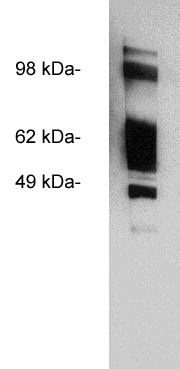Catalogue

Rabbit anti Human HDAC1
Catalog number: X1847P| Isotype | N/A |
| Product Type |
Antigen Immunoaffinity Purified Polyclonal |
| Units | 50 µg |
| Host | Rabbit |
| Species Reactivity |
Human |
| Application |
Western Blotting |
Background
Acetylation of the tail of histone is known to cause chromatin to adopt a more ÔopenÕ 3D conformation, allowing trans factors grerater access to DNA. Histone acetyltransferases (HATs), complexes interact with sequence-specific activator proteins and target specific genes. In addition to histones, HATs acetylate non-histone proteins, implicating them in a wide variety of regulartory roles for these enzymes. By comparison, histone deacetylation promotes a more ÔclosedÕ chromatin conformation and in general leads to repression of gene activity. Mammalian histone deacetylases are divided into three classes on the basis of their similarity to various the yeast deacetylases. Class I (HDACs 1, 2, 3 and 8) related to the yeast Rpd3-like proteins, class II (HDACs 4, 5, 6, 7, 9 and 10) related to yeast Hda1-like proteins and class III related to the yeast protein Sir2. Inhibitors of HDAC have enormous potential as cancer therapeutic agents.
Source
Immunogen: Synthetic peptide derived from the human histone deacetylase 1 protein.
Product
Product Form: Affinity Purified
Formulation: Provided as ligand affinity purified antibody in phosphate buffered saline with 0.08% sodium azide
Purification Method: Antigen Immunoaffiinity Purification
Concentration: Lot specific, see vial
Applications
Antibody can be used for Western blotting (1-5µg/ml). Optimal concentration should be evaluated by serial dilutions.
Functional Analysis: Western Blotting
Positive Control: Antiibody tested on HeLa cell lysate
Storage
Product should be stored at -70°C. Aliquot to avoid freeze/thaw cycles
Product Stability: See expiration date on vial
Shipping Conditions: Ship at ambient temperature, freeze upon arrival
Caution
This product is intended FOR RESEARCH USE ONLY, and FOR TESTS IN VITRO, not for use in diagnostic or therapeutic procedures involving humans or animals. It may contain hazardous ingredients. Please refer to the Safety Data Sheets (SDS) for additional information and proper handling procedures. Dispose product remainders according to local regulations.This datasheet is as accurate as reasonably achievable, but Nordic-MUbio accepts no liability for any inaccuracies or omissions in this information.
References
1. Marmorstein, R. et al. (2001) Cell. Mol. Life Sci. 58, 693-703.
2. Gray, S.G. and Ekstrom, T.J. (2001) Exp. Cell Res. 262, 75-83.
3. Thiagalingam, S. et al. (2003) Ann. N. Y. Acad. Sci. 983, 84-100.
4. Viguishin, D.M. and Coombes, R.C. (2004) Curr. Cancer Drug Targets 4, 205-218.
5.J Virol. 2006 Dec 6; Mapping of key functions of the herpes simplex virus 1 US3 protein kinase: the US3 protein can form functional heteromultimeric structures derived from overlapping truncated polypeptides. Alice P W Poon, Bernard Roizman
6. J Biol Chem. 2006 Nov 22; Molecular mechanisms of trans-activation and doxorubicin mediated repression of survivin gene in cancer cells.
Pierre-Olivier Esteve, Hang Gyeong Chin, Sriharsa Pradhan
7. Curr Drug Targets. 2006 Nov ;7(11):1553-60: The role of NAD+ dependent histone deacetylases (sirtuins) in ageing. Johannes Trapp, Manfred Jung
8. Circ Res. 2006 Nov 2; Transcriptional Silencing of the Death Gene BNIP3 by Cooperative Action of NF-B and Histone Deacetylase 1 in Ventricular Myocytes. James Shaw, Tong Zhang, Marek Rzeszutek, Natalia Yurkova, Delphine Baetz, James R Davie, Lorrie A Kirshenbau
Safety Datasheet(s) for this product:
| NM_Sodium Azide |

" Western blot using Exalpha’s X1847P, affinity purified rabbit polyclonal at 0.5 ug/ml on HeLa cell extract (20 ug/lane). Blots were developed with goat anti-rabbit Ig (1:75k) and Pierce’s Supersignal West Femto system."

